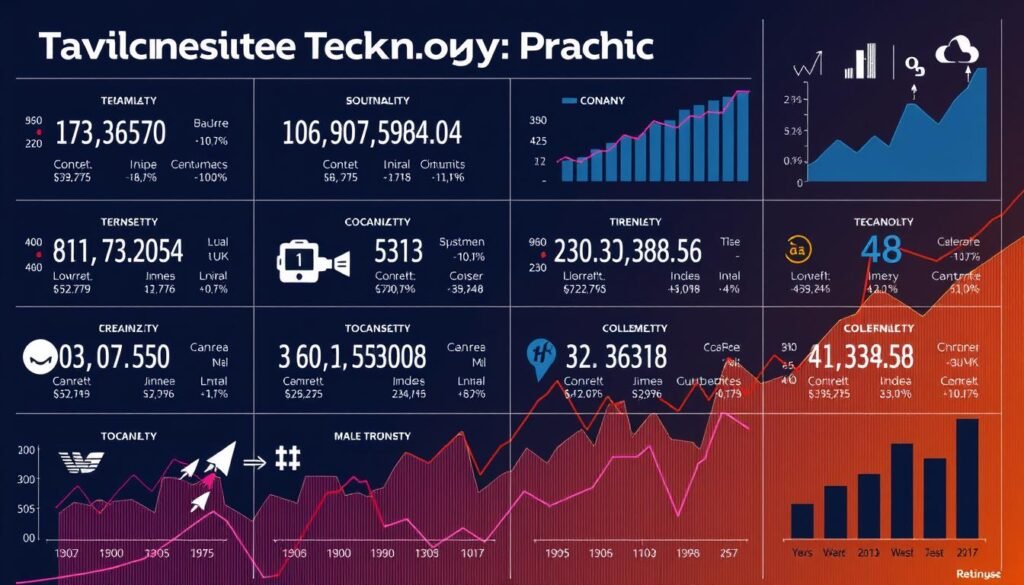The world of technology stocks is both thrilling and volatile. As we navigate through 2025, it’s clear that these stocks are trailing the broader market so far this year.
Despite the S&P 500’s relatively flat performance, with a total return of -0.45% year-to-date through March 5, 2025, the S&P 500 Communication Services and Information Technology sector has seen a total return of -4.42%. This sector comprises a significant two-fifths of the S&P 500’s weighting, making its performance crucial for the overall market.
As investors, understanding the dynamics of technology stocks and their potential for growth is essential. We’ll explore the current landscape, historical performance, and key drivers behind the tech sector’s influence on the economy.
Key Takeaways
- The technology sector remains a critical component of a well-balanced investment portfolio.
- Historical data shows that technology stocks have outperformed the broader market over the long term.
- Emerging technologies like AI and cloud computing are key drivers of growth in the tech sector.
- Understanding the market position of the technology sector is crucial for investors.
- Evaluating technology stocks effectively requires a comprehensive analysis of both established giants and emerging players.
The Current State of Technology Stocks in 2025
The current state of technology stocks is a topic of intense interest, given the recent market turbulence. As investors, we are keenly watching the performance of technology stocks, trying to gauge whether their current underperformance is a temporary setback or a sign of a more significant shift in market dynamics.
Recent Performance Trends
In recent weeks, the stock market has experienced heightened volatility, with technology stocks being the hardest hit. According to expert insights, elevated tech stock valuations could make them more vulnerable if market weakness persists. However, as Haworth notes, “We’d have to see a meaningful earnings deterioration for that to occur, which doesn’t seem likely given current conditions.” This suggests that while there are concerns, the overall performance of technology stocks may not be severely impacted in the short term.
Comparison to Broader Market
To understand the performance of technology stocks, we need to compare them to the broader market indices like the S&P 500. This comparison will provide context for investors and help identify trends. For instance, analyzing sector rotation trends can reveal how technology stocks have been affected relative to other sectors such as energy, financials, and healthcare. Moreover, examining the correlation between technology stocks and broader market movements can highlight when tech tends to outperform or underperform.
By discussing how economic factors like interest rates and inflation have differently impacted technology stocks versus the broader market, we can gain a deeper understanding of the current state of technology stocks. Expert perspectives suggest that while technology stocks may be underperforming currently, this may not necessarily indicate a significant shift in market dynamics.
Understanding the Technology Sector’s Market Position
The technology sector’s influence on the overall market is a critical factor to consider for investors looking to maximize their returns. As technology companies continue to drive innovation and growth, their impact on the market becomes increasingly significant.
According to Haworth, “Technology companies offer the potential for strong earnings growth that’s not specifically connected to the business cycle.” This insight highlights the sector’s resilience and potential for long-term growth.
Technology’s Weight in the S&P500
The S&P 500 index is heavily influenced by the technology sector, with tech giants contributing a substantial portion of the index’s total market capitalization. This concentration underscores the importance of understanding the role of technology stocks within the broader market.
| Sector | Weight in S&P 500 |
|---|---|
| Technology | 28% |
| Healthcare | 14% |
| Financials | 13% |
Key Players Driving the Market
Several key companies are driving the technology sector’s growth, including established giants and emerging players. These companies are leveraging innovative platforms and business models to expand their market share.

By examining the strategies and performance of these key players, investors can gain valuable insights into the technology sector’s future prospects and identify opportunities for growth.
Artificial Intelligence: The Growth Engine for Technology Stocks

As we dive into the world of technology stocks, one trend stands out: the rise of artificial intelligence as a key growth driver. The technology sector is abuzz with the potential of AI to revolutionize industries, from healthcare to finance.
Current AI Investment Landscape
The current AI investment landscape is characterized by significant activity, with companies investing heavily in AI technologies to increase efficiencies and monetize services for end-users. According to Haworth, “What’s not clear yet is how companies investing in AI as a way to increase efficiencies or monetize services for end users will benefit from these advancements.” This uncertainty highlights the need for careful analysis of AI-focused companies.
We’ll examine the potential revenue streams and business models that could emerge from AI investments across different technology subsectors. The business landscape is shifting, with AI-driven services becoming increasingly prominent.
Future Prospects for AI-Focused Companies
Looking ahead, the future prospects for AI-focused companies are promising, with potential for significant growth. We’ll analyze the future growth prospects for companies focused on artificial intelligence technologies and applications. The growth of AI is likely to reshape competitive dynamics within the technology sector over the next decade.
We’ll provide insights into how investors can evaluate the long-term potential of AI-focused companies beyond current hype cycles. As AI continues to evolve, it’s crucial for investors to understand the underlying trends and opportunities.
Cloud Computing: Another Pillar of Tech Growth
As we explore the tech industry’s growth drivers, cloud computing emerges as a significant pillar. Cloud computing is transforming the way businesses operate, providing flexible and scalable solutions.

Business-to-Business Technology Spending
Business-to-business technology spending is on the rise, with companies investing heavily in cloud infrastructure and related services. This trend is driven by the need for digital transformation and improved operational efficiency.
The growth in cloud adoption is expected to continue, driven by the increasing demand for hybrid and multi-cloud strategies. Companies are looking for flexible solutions that can be integrated with their existing infrastructure.
Leading Cloud Infrastructure Providers
Major players in the cloud infrastructure market include AWS, Microsoft Azure, and Google Cloud. These providers are continually innovating, integrating AI capabilities into their platforms to offer more value to their customers.
For instance, Google Cloud is helping customers build out and run AI models and apps on its platform, making it Alphabet’s fastest-growing business.
Evaluating Technology Stock Valuations
The impressive track record of technology stocks, particularly over the past few years, prompts a closer look at their current valuations and potential future performance. As we examine the current state of technology stock valuations, it’s essential to consider both current valuation metrics and the historical context of their performance.
Current Valuation Metrics
To understand the current valuation of technology stocks, we need to look at key metrics such as the price-to-earnings ratio (P/E ratio). The P/E ratio for the technology sector can provide insights into whether the stocks are overvalued or undervalued compared to their historical norms. As of the latest data, the technology sector’s P/E ratio stands at around 25, which is slightly higher than the historical average. This indicates that while technology stocks have been performing well, their price might be at a premium.
| Metric | Current Value | Historical Average |
|---|---|---|
| P/E Ratio | 25 | 20 |
| Dividend Yield | 1.5% | 2% |
Historical Performance Context
Historically, technology stocks have been a significant driver of market returns. A hypothetical $100,000 invested in the S&P500 Communications Services and Information Technology index on December 31, 2018, grew to more than $391,000 by mid-December 2024. This outstanding performance over the past few years underscores the potential of technology stocks. However, it’s also important to consider how technology stocks have performed through different market cycles, including periods of expansion and contraction.
“The technology sector has been a major driver of growth in the S&P500, with its weight in the index continuing to increase over the years.”
As we evaluate technology stock valuations, understanding their historical performance and the factors driving their outperformance is crucial. By analyzing historical examples of technology stock corrections and recoveries, we can gain insights into potential future scenarios. This analysis will help investors make more informed decisions about their technology stock investments.

Top Undervalued Technology Stocks to Consider
In the vast landscape of technology stocks, some companies stand out as being undervalued with strong fundamentals. As investors, we’re always on the lookout for opportunities that can provide significant returns. Here, we’ll explore two categories of undervalued technology stocks: semiconductor companies with growth potential and software and services companies with strong fundamentals.
Semiconductor Companies with Growth Potential
Semiconductor companies are crucial to the technology sector, providing the chips that power everything from smartphones to servers. Some of these companies are currently undervalued due to market fluctuations or other factors.
Key Characteristics: We’re looking for semiconductor companies with a strong track record of innovation, a solid financial position, and a competitive advantage in their niche.
Software and Services with Strong Fundamentals
Software and services companies are another area where we can find undervalued stocks. These businesses often have strong recurring revenue streams and are well-positioned for long-term growth.
Companies like Endava and Nice are examples of undervalued stocks in this category. Endava is trading 58% below our fair value estimate, while Nice is at a 38% discount. Both companies have strong business models and are benefiting from digital transformation trends.
When evaluating these stocks, we consider factors such as their business model, revenue streams, competitive advantages, and valuation metrics. By doing so, we can identify undervalued companies with the potential for significant growth.
Technology Stocks and Economic Factors
As we navigate the complex world of technology stocks, it’s crucial to understand how economic factors influence their performance. The technology sector is sensitive to various economic conditions that can impact stock prices and investor decisions.
Impact of Interest Rates
Interest rates play a significant role in shaping the technology stock market. When interest rates rise, it can become more expensive for companies to borrow money, potentially slowing down business expansion and impacting stock performance. Conversely, lower interest rates can stimulate growth by making borrowing cheaper.
Key considerations: Higher interest rates can lead to increased cost of capital for technology companies, affecting their ability to invest in new projects. On the other hand, lower rates can boost investment in technology by making it cheaper to finance growth initiatives.
| Interest Rate Change | Impact on Technology Stocks |
|---|---|
| Increase | Higher borrowing costs, potentially slowing growth |
| Decrease | Cheaper borrowing, potentially boosting growth |
Trade Policies and Global Supply Chains
Trade policies and global supply chain dynamics significantly impact technology companies and their stock performance. Tariffs and trade restrictions can increase costs and disrupt supply chains, affecting companies’ competitive positioning.
For instance, the Trump administration’s focus on expanding tariffs with major trading partners could potentially dampen economic growth. According to Haworth, “In a slowing growth environment, technology stocks tend to hold up better because they aren’t as subject to cyclical economic patterns.”
We analyze how trade policies affect technology companies, examining their exposure to international markets and global supply chains. This includes discussing how tariffs impact cost structures and competitive positioning, as well as how companies adapt their supply chains in response to evolving trade policies.
- Assessing the impact of tariffs on technology companies’ cost structures
- Examining the exposure of different technology subsectors to global supply chains
- Understanding how technology companies adapt to changes in trade policies
Risk Management When Investing in Technology Stocks
As we explore the world of technology stocks, it’s crucial to understand the risk management strategies that can help investors make informed decisions. The technology sector is known for its dynamic nature, with rapid innovations and shifting market trends. Effective risk management is essential to navigate this complex landscape.
Volatility Considerations
Technology stocks are often characterized by high volatility, which can result in significant gains or losses. To manage this volatility, investors should stay informed about market trends and be prepared to adjust their portfolios accordingly. According to Haworth, the technology sector’s dominance is expected to gradually level off, potentially leading to a more balanced market.
Understanding the factors that contribute to volatility, such as economic indicators and industry-specific news, can help investors make more informed decisions. By being aware of these factors, investors can better navigate the ups and downs of the technology market.
Diversification Strategies
Diversification is a key strategy for managing risk in technology investments. By spreading investments across different subsectors within the technology sector, as well as across other sectors, investors can reduce their exposure to any one particular stock or industry. This can help balance the potential for high growth with more stable returns.
To achieve effective diversification, investors can consider a mix of technology stocks, including those in areas like artificial intelligence, cloud computing, and semiconductor manufacturing. Additionally, investing in other sectors, such as healthcare or consumer goods, can further reduce risk. The table below illustrates a sample diversification strategy.
| Sector | Investment Allocation |
|---|---|
| Technology | 40% |
| Healthcare | 20% |
| Consumer Goods | 20% |
| Financial Services | 20% |
Building a Technology-Focused Investment Portfolio

To succeed in technology investing, it’s crucial to understand the nuances of the market. Haworth notes that investors need to be selective in their approach to this sector. While some technology startups achieve tremendous success, many firms fail to get off the ground.
Balancing Growth and Value in Tech
A balanced technology portfolio combines growth and value stocks. Growth stocks, such as companies in the AI or cloud computing sectors, offer the potential for high returns, albeit with higher risk. Value stocks, on the other hand, are often undervalued companies with strong fundamentals that can provide stability. Investors should assess their risk tolerance and financial goals when deciding on the right balance.
Long-term vs. Short-term Investment Approaches
When investing in technology stocks, investors can adopt either a long-term or short-term approach. A long-term strategy involves holding onto stocks for several years, riding out market fluctuations, and benefiting from the compounding effect. In contrast, a short-term approach involves actively trading stocks to capitalize on market volatility. Both strategies have their merits and drawbacks, and investors can combine them to optimize their technology exposure.
By understanding the differences between these approaches and considering their personal time horizon and financial goals, investors can develop a technology investment strategy that works for them.
Conclusion: Making Informed Decisions on Technology Investments
As investors navigate the technology market, understanding the key trends and insights is essential. Throughout this article, we’ve explored the current state of technology stocks, the growth potential of artificial intelligence and cloud computing, and the importance of evaluating stock valuations.
We’ve also discussed the impact of economic factors on tech investments and strategies for managing risk. By balancing optimism about long-term growth with realistic expectations about near-term volatility, investors can make informed decisions.
To stay ahead, investors should continue to monitor rapidly evolving technology trends and their implications for the market. A well-rounded investment strategy that includes technology stocks can provide value and growth opportunities. As you assess the most effective ways to position your portfolio consistent with your goals and time horizon, be sure to consult with your financial professional.
